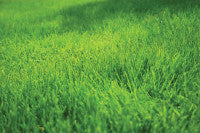Grass – a natural choice
 With environmental issues becoming more topical and harder to ignore, the argument in favour of natural turf strengthens all the time. In a report written by the European Seed Association (ESA) titled "Why Choose Natural Turf"1 the evidence states clearly that turf grass is better for the environment. It is safer and healthier for the players as well as being a cost effective alternative to installing and maintaining artificial turf.
With environmental issues becoming more topical and harder to ignore, the argument in favour of natural turf strengthens all the time. In a report written by the European Seed Association (ESA) titled "Why Choose Natural Turf"1 the evidence states clearly that turf grass is better for the environment. It is safer and healthier for the players as well as being a cost effective alternative to installing and maintaining artificial turf.
Grass is often under estimated. We forget that it offers habitation for birds and insects as well as micro organisms which can break down air pollutants. Grass acts as a drainage system absorbing and filtering rainfall and is considerably cooler than artificial turf as demonstrated at Brigham Young University in 2002.2 Here results showed that the synthetic field was 39°C higher than natural turf and at its hottest point was 86.5°C hotter.
Research from Pennsylvania State University has identified that surface temperatures of synthetic turf surfaces are between 35-600 higher than natural turf grass surface temperatures.3 In order to reduce the temperature of synthetic turf and avoid skin burns, irrigation may be necessary. However the study at Brigham Young University showed that cooling the synthetic turf with water had little effect on its temperature.2
We are told that our climate is changing rapidly and we need to reduce carbon dioxide in the atmosphere. In fact grass is able to fix carbon dioxide and thus reduce it at the same time as provide us with oxygen. Research carried out by Initiative W M-Rasen e.v.-Weissbuch4 showed that a natural football pitch would produce enough oxygen for 120 people per year.
Dedicated research and development at grass breeder companies like DLF Trifolium has ensured that grass seed has evolved to cope well with unpredictable weather patterns from periods of drought to torrential rainfall, as well as shade and other climatic pressures. Developments in breeding have meant that many problems a natural turf may face such as shade, air circulation and wear tolerance have been overcome. Not only have species been adapted to cope with these kinds of pressure e.g. perennial ryegrass and smooth stalked meadow grass but new species, such as tall fescue, have been introduced. This has meant that as well as all the environmental benefits already mentioned, grass is self repairing and therefore much more cost effective.
On the other hand an artificial pitch 'loses' 3 tonnes of material each year, just through normal play, with an effect on the environment and human health. Renewal of an artificial pitch produces 250 tonnes of waste including 20 tonnes of Polyethylen fibres, Polypropylen and latex plus 105 tonnes of rubber granulates and 127 tonnes of sand.4
In the United States, the Consumer Product Safety Commission (CPSC) has begun investigating potential hazards from lead in some artificial turf sports fields across the country. Two fields in New Jersey were closed in April 2008 after state health regulators found high levels of lead in turf fibre samples.5 The US Environmental Protection Agency (EPA) will play a supporting role in the investigation regarding health concerns posed by synthetic turf.5
A report developed and managed by the Environment and Human Health Inc. entitled "Artificial Turf: Exposures to Ground up Rubber Tyres - Athletic Fields, Playgrounds, Garden Mulch."6 has demonstrated that ground-up recycled tyres (tyre crumbs) used as in-fill material in synthetic turf, release chemical compounds into the air and water, constituting chemical exposure to humans and the environment. Health concerns
associated with materials released from recycled crumb rubber include acute irritation of the lungs, skins and eyes; systemic effects on the liver and kidneys; neurotoxic responses; allergic reactions and cancers. The report recommends that a moratorium is placed on in stalling any new artificial pitches which use these tyre crumbs.
stalling any new artificial pitches which use these tyre crumbs.
Players are concerned about the injuries associated with artificial turf which include turf burns, first metatarsophalangeal joint sprain otherwise known as Turf Toe; Anterior Cruciate Ligament injuries and foot lock. In an Opinion Survey carried out by US based National Football League Players' Association, players were asked which surface they thought was more likely to contribute to injury and 91.18% said artificial turf.7
Finally there is the issue of cost. In the first instance, initial investment of a natural turf pitch is much more economical than a rubber in-filled pitch. Subsequently, due to the introduction of new and improved grass species, considerable savings can be made with the maintenance of natural turf and when renovated or re-seeded the surface layer can be used for compost. Recycling artificial turf is another story and the costs are high both in economical and environmental terms.1
Therefore once you consider all these factors - costs, health implications, environmental issues - and then look at the huge developments being made in grass breeding, the choice seems quite a natural one.
References:
1. http://www.euroseeds.org
2. Williams, C. Frank, and Gilbert E. Pulley. "Synthetic Surface heat Studies", Brigham Young University, 2002. retrieved Nov. 2005 from turf.nmsu.edu
3. http://cropsoil.psu.edu/mcnitt/infill7a.cfm
4. http://www.initiative-wm-rasen.de
5. http://www.usatoday.com
6. http://www.ehhi.org/reports/turf/
7. Source: TPI newsletter, Turfnews - August 2005
Bibliography:
Natural Grass and Artificial Turf: Separating Myths and Facts. Published by the Turfgrass Resource Center http://www.turfresourcecenter.org
For further information about grass breeding and the latest turf mixtures available, please visit www.dlf.co.uk/
For further details regarding this press release, please contact Miranda Harris: Tel: 01386 791120, Mobile 0788 7897673, Email mharris@dlf.co.uk
